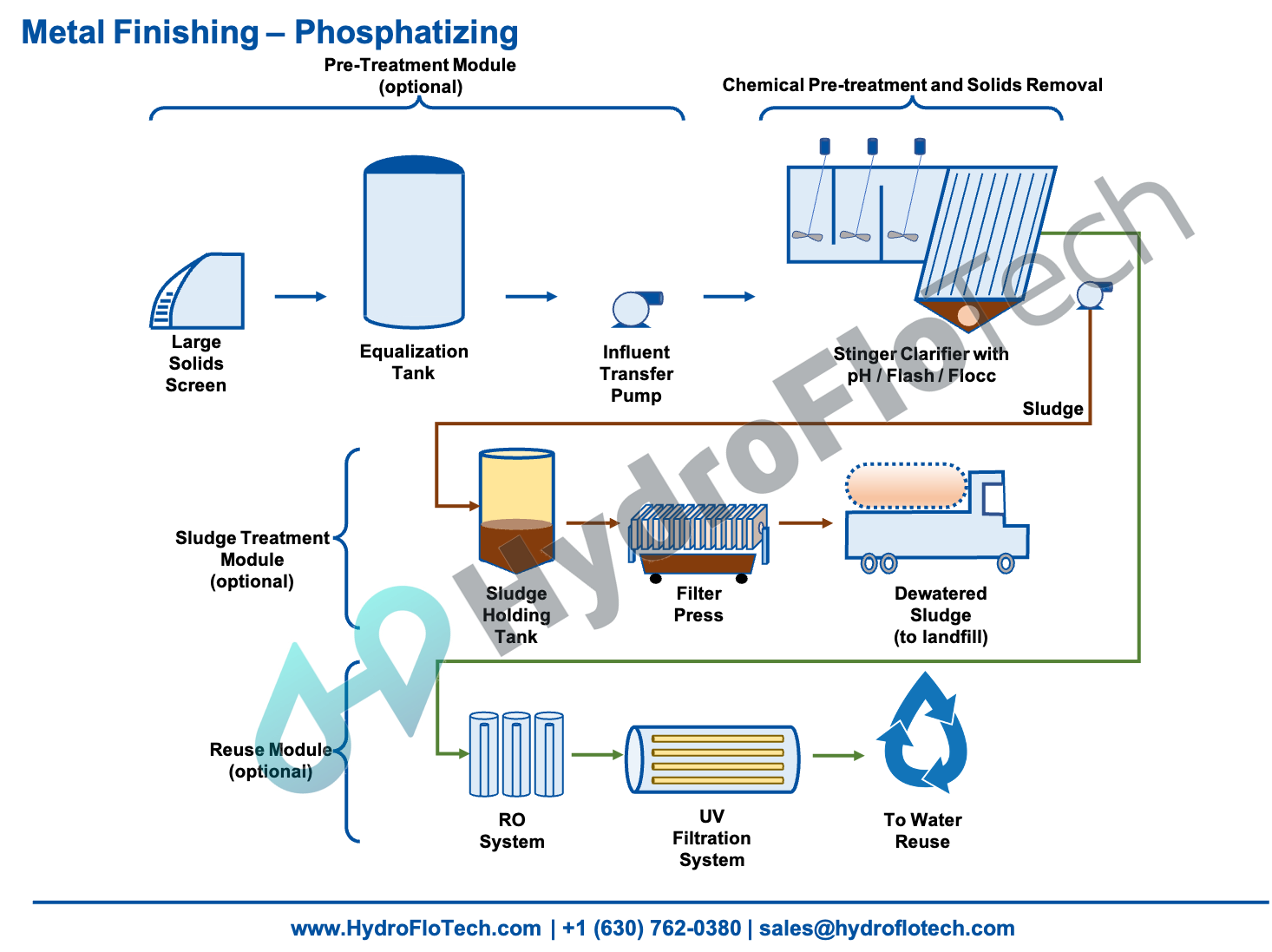Phosphatizing
Phosphatizing wastewater is from metal surface preparation operations where the metal is either sprayed or dipped in a hot phosphatizing solution. The phosphatized metal surface is then ready for painting, bonding with plastic or rubber, cold extrusion or alone as a metal preservative. Typical clients are in the following industries:
• Can making plants – phosphatizing for corrosion resistance
• Steel coil coating – large steel coils are phosphatized for corrosion resistance and painting preparation.
• Metal forming such as conduit, nails, nuts, bolts and screws, electrical parts.
• Aerospace – corrosion resistance surface prep
• Appliance makers – phosphatizing is done to internal parts for corrosion resistance prior to painting
• Computer component makers – phosphatizing is used as a dielectric surface prep
Design Considerations
Phosphatizing wastewater typically from rinsing and batch dumps is at a low pH of ~2.5, is hot (~110F), and contains a soluble form of phosphate. In order to remove this soluble form of phosphate it must first be made insoluble. The insoluble phosphate is then coagulated, flocculated and clarified by sedimentation.
HydroFloTech has designed a fully modular system for phosphate removal from wastewater:
Pre-Treatment Module: This module removes large solids and equalizes the water prior to any further treatment. The goal of this module to get the water provide the downstream treatment equipment with an equalized stream of water which if free from large solids.
Side Hill Screen / Grit Removal System: “Side hill” or “Grit Removal Systems” are used for the removal of large insoluble material from wastewater flows. These screens or systems are used on process and wastewater streams for particles that need to be removed to protect downstream systems. These screens can also be used for product recovery; large solids separation and mixed settleable solids for both municipal and industrial applications.
The HydroFloTech Side Hill Screen or Grit Removal System maximize solids removal in an easy to maintain unit. The screen is a barrier by which material larger than the gap or slot size may not pass, allowing the water to continue through.
Equalization Tank: HydroFloTech can work with an existing equalization “EQ” tank or provide one. Materials of construction can includes: Fiberglass (FRP), HDPE, steel (carbon steel or stainless steel), concrete, or even in-ground storage pits / ponds. The purpose of the equalization tank is to “equalize” and narrow any variances in water characteristics. The EQ tank also acts as a great buffer for two main purposes: First the EQ tank provides a buffer storage capacity in situations when there is a temporary surge in flowrate. This allows the system to be smaller than the peak surge flowrate. Secondly, the EQ tank also provides the ability to “narrow” any spikes in any contaminants.
Chemical Pre-Treatment and Solid Removal: This module chemically treats the water with pH adjustment (as necessary), coagulant and polymers to enhance the ability of HydroFloTech inclined plate clarifiers or dissolved air floatation systems (DAF) to effectively remove any Total Suspended Solids (TSS) or Fats, Oils and Grease (FOG).
ChemiSep Chemical Pre-Treatment System: The efficacy of any wastewater is as good as the pre-treatment of the wastewater prior to removal of any impurities. The HydroFloTech ChemiSep Pre-Treatment System provides great flexibility in treating various wastewater profiles:
- Stage 1 – Precipitation & Coagulation: pH is raised from ~2.5 to 8.5 with the pH controller using caustic while adding a coagulant such as ferric chloride. Testing of the wastewater may confirm that a coagulant is not needed. A “pin floc” is developed indicating the phosphate is insoluble.
- Stage 2 – Flash-Mix: The wastewater with it’s precipitated pin floc is introduced to the flash mix zone where a polymer flocculent is added. This stage maximizes flocculent dispersion throughout the coagulated wastewater.
- Stage 3 – Flocculant: The wastewater is now introduced to the slow mix zone to agglomerate the pin floc into larger rapid settling particles.
Stinger Clarifer / ClariMax Clarifier: The flocculated wastewater is introduced into the clarifier where the settling particles accumulate in the sludge chamber. The clarified water then exits the clarifier and flows downstream to sewer or further treatment if necessary.
Sludge Management System: This module removes the precipitated solids from the water and converts those solids into dewatered “sludge” which may be eligible for re-use or landfill disposal.
Sludge Tank with Sludge Transfer Pump: The accumulated sludge is periodically removed from the clarifier and sent to a sludge holding tank where it further thickens for disposal or dewatering.
Sludge Dewatering: Sludge dewatering is typically handled by a HydroPress Filter Press or Screw Press. After processing a batch of “sludge” the filter press or screw press is emptied of “chrome cake” which is a semi solid of approximately 20-35 % solids. Chrome cake is high in chrome and sulfite and should be disposed of according to environmental regulations.
Re-Use Module: This module further reduces any remaining solids and biological / bacterial growth in the water to make it suitable for re-cycling or re-use.
RO System: The RO System removed any remaining dissolved solid (TDS) in the wastewater. The effluent coming out of the RO System is suitable for re-cycling / re-use.
UV Filter System: The UV Filter System finishing a final sanitizing of the water. The UV Filter System allows for the treated water to be used for most re-use / recycling purposes.


